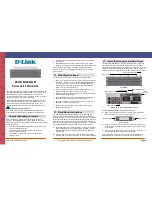
Federal Communication Commission Interference Statement
FCC ID: TV7R11E2HPND
This equipment has been tested and found to comply with the limits for a Class B digital device, pursuant to Part 15 of the FCC Rules. These
limits are designed to provide reasonable protection against harmful interference in a residential installation
This equipment generates, uses, and can radiate radio frequency energy and, if not installed and used in accordance with the instructions, may
cause harmful interference to radio communications. However, there is no guarantee that interference will not occur in a particular installation. If
this equipment does cause harmful interference to radio or television reception, which can be determined by turning the equipment off and on, the user is
encouraged to try to correct the interference by one or more of the following measures:
Reorient or relocate the receiving antenna.
Increase the separation between the equipment and receiver.
Connect the equipment into an outlet on a circuit different from that to which the receiver is connected.
Consult the dealer or an experienced radio/TV technician for help.
FCC Caution: Any changes or modifications not expressly approved by the party responsible for compliance could void the user’s authority to operate this
equipment.
This device complies with Part 15 of the FCC Rules. Operation is subject to the following two conditions: (1) This device may not cause harmful interference, and
(2) this device must accept any interference received, including interference that may cause undesired operation.
Note: This unit was tested with shielded cables on the peripheral devices. Shielded cables must be used with the unit to ensure compliance.
Antenna Installation WARNING: It is the installer's responsibility to ensure that when using the authorized antennas in the USA (or where FCC rules apply); only
those antennas certified with the product are to be used. The installer should configure the output power level of antennas, according to country regulations and
per antenna type. Professional installation is required for equipment with connectors to ensure compliance with health and safety issues.
Approved 2.4 GHz Antennas:
5 dBi Omnidirectional (Model: WAI-050)
13 dBi Omnidirectional (Model: ODH 24-13)
15 dBi Omnidirectional (Model: WLO-2450-15)
17 dBi Sector (Model: SA 24-90-17-WB)
20 dBi Omnidirectional (Model: WLP-2450-20)
24 dBi Omnidirectional (Model: DC 24-HD-PFIP)
*The same type of antenna and lower antenna gain than those listed above may also be used in accordance with the certification
OEM statement. This module is intended for OEM installations only. As such the OEM integrator is responsible for ensuring that the end-user has no manual
instructions to remove install or modify the module. This module is limited to installations in mobile or fixed applications. OEM integrators may utilize antennas of
an equal or lesser gain as appearing in the list in this document (reference 47 CFR, paragraph 15.204(c)(4) for further information on this topic. The MikroTik OEM
RF Module complies with Part 15 of the FCC rules and regulations.
OEM Modules have been certified by the FCC for use with other products without any further certification (as per FCC section 2.1091). Separate approval is
required for other operating configurations including portable configurations with respect to 47CFR paragraph 2.1093 and different antenna configurations. The
OEM is required to comply with all 47CFR labeling instructions and requirements for the finished products.
Changes or modifications not expressly approved by MikroTik could void the OEM authority to install or operate the equipment. OEMs must test their final product
to comply with unintentional radiators (FCC section 15.107 and 15.109) before declaring compliance with their final product to Part 15 of the FCC Rules.
Innovation, Science and Economic Development Canada
IC: 7442A-R11E2HPND
This device contains license-exempt transmitter(s)/receiver(s) that comply with Innovation, Science, and Economic Development Canada’s license-exempt RSS(s).
Operation is subject to the following two conditions: (1) This device may not cause interference. (2) This device must accept any interference, including
interference that may cause undesired operation of the device.
L’émetteur/récepteur exempt de licence contenu dans le présent appareil est conforme aux CNR d’Innovation, Sciences et Développement économique Canada
applicables aux appareils radio exempts de licence. L’exploitation est autorisée aux deux conditions suivantes: 1) L’appareil ne doit pas produire de brouillage; 2) L’
appareil doit accepter tout brouillage radioélectrique subi, même si le brouillage est susceptible d’en compromettre le fonctionnement.
This Class B digital apparatus complies with Canadian ICES-003.
Cet appareil numérique de la classe [B] est conforme à la norme NMB-003 du Canada.
CAN ICES-003 (B) / NMB-003 (B)
Antenna Installation WARNING: It is the installer's responsibility to ensure that when using the authorized antennas in Canada (or where IC rules apply); only those
antennas certified with the product are to be used. The installer should configure the output power level of antennas, according to country regulations and per
antenna type. Professional installation is required for equipment with connectors to ensure compliance with health and safety issues.
Approved 2.4 GHz Antennas:
5 dBi Omnidirectional (Model: WAI-050)
13 dBi Omnidirectional (Model: ODH 24-13)
15 dBi Omnidirectional (Model: WLO-2450-15)
17 dBi Sector (Model: SA 24-90-17-WB)
20 dBi Omnidirectional (Model: WLP-2450-20)
24 dBi Omnidirectional (Model: DC 24-HD-PFIP)
*The same type of antenna and lower antenna gain than those listed above may also be used according to certification
UKCA marking



































